Custom crane for various industrial use in Kuwait. Check customization trends in Kuwait's overhead crane industry. Hot sale 3 ton, 5 ton, 10 ton, 20 ton, 30 ton, up to 100 ton.
Customization Trends in Kuwait's Overhead Crane Industry
Kuwait stands as a vibrant nexus of diverse industries, each with its unique demands and challenges. Amidst this dynamic landscape, the role of overhead cranes emerges as indispensable. These towering mechanical giants play a pivotal role across various sectors, ranging from oil and gas to construction and manufacturing. They are the silent heroes that enable the smooth operation of heavy lifting, precise movements, and logistical tasks within Kuwait's industrial framework.
The thesis of this exploration is clear: delving into the innovative trends in customizing overhead cranes to cater specifically to Kuwait's industrial requirements. Understanding the intricacies of Kuwait's industrial landscape is crucial to appreciate the significance of these customizations. The adaptive and tailored nature of these overhead cranes becomes essential in meeting the diverse needs of Kuwait's multifaceted industries.
Kuwait boasts a multifaceted industrial landscape, primarily driven by its oil and gas reserves, construction projects, manufacturing units, and logistical hubs. The oil and gas industry, a cornerstone of Kuwait's economy, demands robust equipment capable of handling heavy loads with utmost precision and safety. Simultaneously, the burgeoning construction sector requires cranes capable of accommodating variable site requirements and lifting capacities.
Overhead cranes serve as the backbone of Kuwait's industrial operations. Their versatility allows for intricate movements and heavy lifting tasks that are integral to various industries. These cranes facilitate efficiency in production, streamline logistical operations, and enhance safety measures within industrial facilities.
General Use Overhead Cranes for Sale Kuwait
Kuwait's Industrial Requirements
Kuwait's industrial landscape is a mosaic of sectors, each playing a pivotal role in the nation's economy. The oil and gas sector, a cornerstone of Kuwait's wealth, demands precision and robustness in lifting equipment due to heavy loads involved in extraction and processing. Similarly, the construction industry, thriving on ambitious infrastructure projects, requires versatile cranes adaptable to different site conditions and lifting capacities. Moreover, the manufacturing sector necessitates efficient handling of materials and components to streamline production processes.
Each sector in Kuwait faces unique challenges that necessitate specialized solutions. The oil and gas industry contends with the handling of massive loads in often hazardous environments, demanding the highest safety standards and precision. Meanwhile, the construction sector grapples with variable site conditions, ranging from confined spaces to towering heights, necessitating adaptable crane configurations. The manufacturing industry requires precision handling and logistics, optimized for seamless production lines.
Oil and Gas Sector:
Specific Demands: Within the oil and gas sector, the primary demand revolves around the handling of colossal loads prevalent in hazardous environments during extraction, transportation, and processing. The requirement is for heavy-duty cranes capable of withstanding extreme conditions, maintaining utmost precision, and adhering to the highest safety standards.
Challenges include ensuring the safe lifting and movement of heavy loads, often in confined spaces or areas with limited accessibility. The need for precision and reliability is crucial due to the delicate and potentially volatile nature of the materials involved in this sector.
Construction Industry:
Specific Demands: Kuwait's construction industry requires cranes adaptable to a wide array of site conditions, from compact, confined spaces to soaring heights of skyscrapers and bridges. The demand is for versatile cranes capable of handling varying lifting capacities and configurations to accommodate diverse construction scenarios.
Challenges encompass adapting to unpredictable terrain, handling different lifting heights, and variable load capacities while maintaining safety and efficiency. Crane configurations must be flexible to swiftly adapt to changing construction site requirements.
Manufacturing Sector:
Specific Demands: In Kuwait's manufacturing sector, the demand is for cranes that facilitate precise handling and logistics, seamlessly integrating into production lines. The requirement is for cranes optimized to efficiently manage materials and components, contributing to the streamlined operation of manufacturing processes.
Challenges involve the necessity for precise handling, ensuring efficient logistics within the manufacturing process, and integrating crane operations seamlessly into production cycles. The goal is to minimize interruptions and maintain a continuous and efficient production flow.
In summary, each sector in Kuwait's industrial landscape presents unique demands and challenges. The oil and gas industry requires robust, precise, and safe handling of heavy loads in hazardous environments. The construction sector necessitates adaptable crane configurations to accommodate varying site conditions, while the manufacturing sector emphasizes precise handling and logistics optimization within production lines. Tailoring crane solutions to address these sector-specific challenges is essential in ensuring optimal performance and meeting the diverse industrial needs of Kuwait.
The adaptability of overhead cranes to cater to the unique demands of each sector signifies the importance of customization in Kuwait's industrial landscape. These machines, when tailored to specific requirements, become instrumental in overcoming the challenges posed by Kuwait's diverse industries.
Evolution of Overhead Crane Customization
Historical Perspective: Development of Standard Overhead Crane Models
The evolution of overhead cranes traces back to their standardization, where early models were designed to serve general purposes across industries. These conventional models offered a basic framework for lifting and moving heavy loads but lacked the adaptability required to meet the specific needs of various sectors. Over time, technological advancements and industry demands spurred a significant shift in the crane manufacturing landscape.
- Early Development: - Standardization and General Purposes: The origins of overhead cranes can be traced back to their standardization, primarily designed to serve general lifting and moving purposes across industries. These early models provided a basic framework for handling heavy loads and facilitating movement within industrial settings.
- Limitations of Conventional Models: - Lack of Adaptability: While these conventional models were efficient for basic lifting tasks, they lacked the adaptability required to cater to the diverse and specific needs of various industrial sectors. Their standardized design limited their functionality and customization options.
- Technological Advancements and Industry Demands: - Shift in Crane Manufacturing Landscape: Over time, the evolution of technology and the increasing demands of various industries necessitated a significant shift in the crane manufacturing landscape. Industry-specific demands called for cranes that could adapt to different operational environments and perform specialized tasks efficiently.
- Transformation in Crane Designs: - Customization and Adaptability: Technological advancements in engineering and materials, coupled with the rising demands for sector-specific solutions, led to a transformation in crane designs. Manufacturers began to prioritize adaptability and customization, developing cranes capable of meeting the unique requirements of different industries.
- Meeting Sector-Specific Needs: - Tailored Solutions: This shift marked a departure from standardized designs towards tailored solutions. The focus shifted towards creating overhead cranes that could be customized to suit the specific demands of sectors like oil and gas, construction, and manufacturing. These tailored solutions aimed to optimize operations and enhance efficiency within each sector.
- Evolutionary Impact: - Enhanced Efficiency and Safety: The evolution from standardized to customized overhead crane models significantly impacted industrial operations. The tailored designs led to enhanced operational efficiency, increased safety measures, and minimized downtime across diverse industrial settings.
This transformation in crane manufacturing represents a pivotal shift from standardized designs to the development of adaptable, sector-specific overhead crane solutions. The emphasis on customization and adaptability has revolutionized the crane industry, allowing for optimized operations and addressing the unique needs of various industrial sectors.
Customization: Factors Driving the Need for Tailored Solutions
The progression from standardized cranes to customized solutions was propelled by several factors. Industry demands for increased efficiency, safety, and productivity led to a paradigm shift. Manufacturers recognized the necessity of tailoring crane designs to accommodate the unique challenges faced by different sectors in Kuwait's industrial landscape. The advent of advanced engineering techniques, coupled with technological innovations, further fueled this shift towards customization.
- Industry Demand for Enhanced Efficiency, Safety, and Productivity: - Paradigm Shift: The transition from standardized cranes to customized solutions stemmed from the industries' increased demand for improved efficiency, safety, and productivity. Standardized models lacked the specialized features required to address sector-specific challenges effectively.
- Recognizing the Need for Tailored Crane Designs: - Addressing Unique Sector Challenges: Manufacturers acknowledged the necessity of tailoring crane designs to meet the distinct challenges faced by different sectors in Kuwait's industrial landscape. The realization that a one-size-fits-all approach was inadequate prompted the shift towards tailored solutions.
- Technological Advancements and Advanced Engineering Techniques: - Fueling Customization: The advent of advanced engineering techniques and rapid technological innovations played a pivotal role in driving the shift towards customization. These advancements empowered manufacturers to design and produce cranes with intricate specifications tailored to suit diverse industrial requirements.
- Adapting to Sector-Specific Challenges: - Sector-Specific Solutions: As industries in Kuwait faced unique challenges, such as heavy load handling in oil refineries or adaptable configurations in construction, the need for cranes capable of meeting these specific challenges became evident. Customized crane designs became imperative to optimize operations and ensure safety and efficiency within each sector.
- Emphasis on Advanced Features and Specialized Capabilities: - Meeting Industry Needs: The customization trend gained momentum as manufacturers focused on incorporating advanced features and specialized capabilities into crane designs. This shift ensured that cranes could precisely address the intricate demands of Kuwait's diverse industrial sectors.
- Role in Enhancing Industrial Operations: - Driving Operational Excellence: The shift towards customized crane solutions has significantly contributed to driving operational excellence across Kuwait's industrial landscape. Tailored designs offer optimized functionalities, increased safety measures, and improved productivity, aligning cranes precisely with sector-specific requirements.
The evolution towards customized overhead crane solutions in Kuwait's industrial landscape was propelled by the need to enhance operational efficiency, ensure safety, and meet the diverse and unique challenges faced by different sectors. Technological advancements and a strategic focus on addressing sector-specific demands were instrumental in driving this transformative shift.
Case Studies Showcasing Successful Customized Overhead Crane Implementations in Kuwait
Several noteworthy case studies stand as testaments to the success of customized overhead crane implementations in Kuwait. These instances highlight how tailored solutions have addressed specific challenges within diverse industries. From precision lifting in oil and gas facilities to adaptable crane configurations in construction sites, these case studies underscore the efficacy of customized overhead cranes in optimizing operations and enhancing safety.
Precision Lifting in Oil and Gas Facilities:
- Challenge: Oil and gas facilities often deal with heavy loads and intricate lifting operations in hazardous environments.
- Case Study Overview: A notable case involved the implementation of a customized overhead crane equipped with specialized lifting mechanisms and safety features in a Kuwaiti oil refinery. This crane was tailored to handle precise lifting operations for critical equipment and materials within the refinery.
- Outcome: The tailored solution significantly improved efficiency by enabling precise and safe handling of heavy loads in challenging environments, reducing operational risks, and enhancing overall productivity.
Adaptable Crane Configurations in Construction Sites:
- Challenge: Construction sites in Kuwait face diverse terrain and variable lifting requirements, necessitating adaptable crane configurations.
- Case Study Overview: A construction project in Kuwait employed a customized overhead crane equipped with versatile configurations and adjustable features to accommodate different site conditions. The crane's adaptability allowed it to maneuver efficiently in confined spaces and handle varying lifting capacities.
- Outcome: The tailored crane solution optimized construction operations, ensuring flexibility and efficiency while minimizing downtime due to adjustments required for different project phases or site conditions.
Manufacturing Efficiency Enhancement:
- Challenge: Manufacturing facilities seek efficient material handling and integration into production lines.
- Case Study Overview: A manufacturing plant in Kuwait integrated customized overhead cranes designed for precise material handling and seamless integration into production processes. These cranes were tailored with advanced control systems to optimize logistics within the manufacturing setup.
- Outcome: The tailored crane solution streamlined material handling, minimized disruptions in production cycles, and enhanced overall manufacturing efficiency.
Safety Enhancements and Accurate Handling:
- Challenge: Ensuring safety and precision in handling within industrial environments.
- Case Study Overview: A case involved the installation of customized overhead cranes equipped with advanced sensors and precision controls in various Kuwaiti industrial sectors. These cranes were tailored to provide real-time data on load capacities, ensuring precise and safe handling operations.
- Outcome: The customized crane solutions significantly improved safety standards, minimized risks associated with heavy lifting, and enhanced overall operational accuracy.
These case studies highlight the effectiveness of tailored overhead crane solutions in Kuwait's diverse industrial sectors. The success stories demonstrate how customization addresses specific challenges, optimizes operations, enhances safety measures, and drives efficiency within each sector's unique operational environments.

Geneal use crane
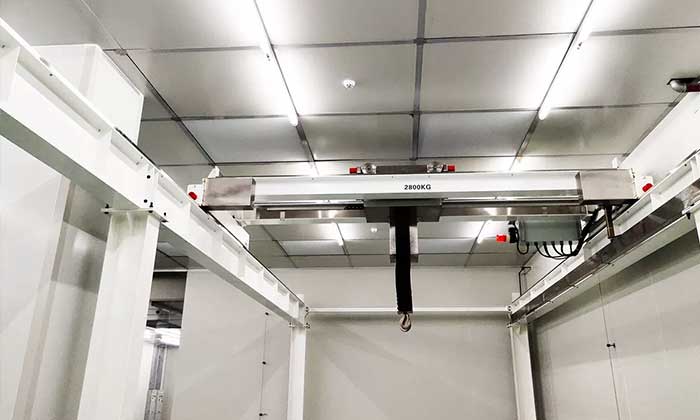
Crane for food and brevage handling crane-clean room hoist and crane
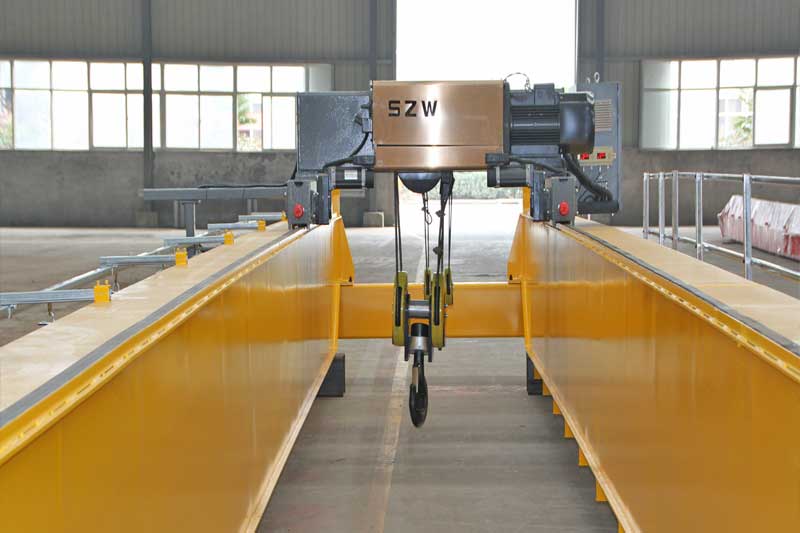
Geneal use overhead crane
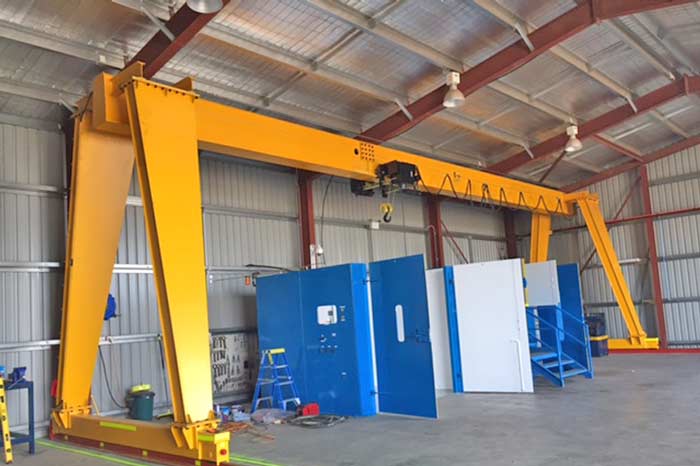
General use gantry crane

Waste handling crane
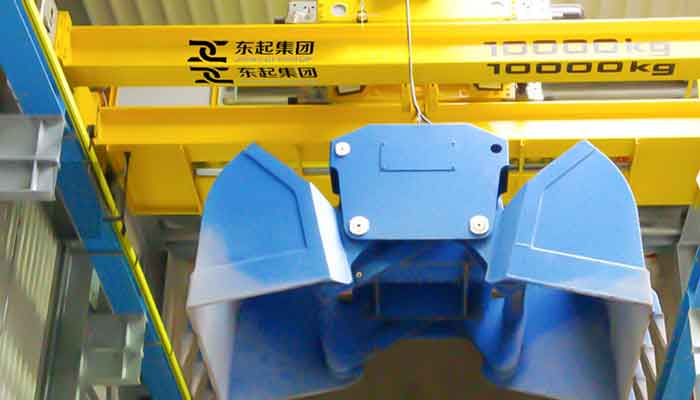
Grab bucket overhead cranes
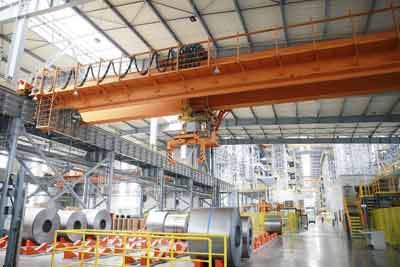
Workstation crane
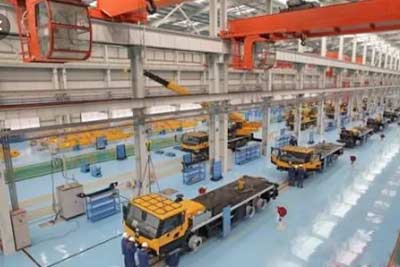
Workstation crane
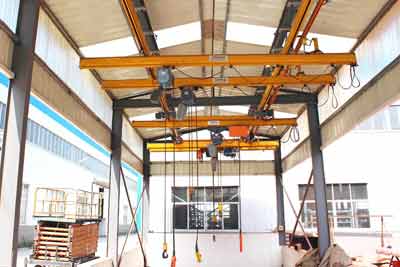
Monorail cranes
Advancements in Crane Design and Engineering for Specialized Industrial Needs
Innovation in crane design and engineering has undergone a transformative phase to meet the evolving demands of Kuwait's industries. Manufacturers are now developing cranes with modular designs, enabling flexibility and adaptability to diverse industrial settings. These advancements cater to specialized lifting requirements, offering enhanced load capacities, improved maneuverability, and durability, specifically tailored to the unique demands of Kuwait's industrial landscape.
Modular Designs for Flexibility and Adaptability:
- Customizable Configurations: Manufacturers have embraced modular designs in crane engineering, allowing for adaptable configurations. These designs enable customization according to specific lifting requirements, operational environments, and varying industrial settings within Kuwait.
- Enhanced Flexibility: Modular designs provide the flexibility to adjust crane functionalities, such as lifting capacities, boom lengths, and control systems, ensuring adaptability to diverse industrial needs.
Addressing Specialized Lifting Requirements:
- Tailored Solutions: Cranes are now developed with a focus on addressing specialized lifting requirements prevalent in Kuwait's industrial sectors. These advancements cater to precise handling needs, whether for heavy loads in the oil and gas sector or intricate movements in manufacturing facilities.
- Improved Load Capacities: Advancements in crane design have led to improved load capacities, enabling cranes to handle heavier loads efficiently, thus meeting the demands of industrial operations.
Improved Maneuverability and Durability:
- Enhanced Maneuverability: Crane engineering advancements emphasize improved maneuverability to navigate diverse terrains and operational spaces, especially in construction and industrial environments with limited access.
- Enhanced Durability: Innovations in materials and engineering techniques have led to cranes with increased durability, capable of withstanding challenging conditions prevalent in Kuwait's industrial landscape, such as extreme temperatures and corrosive environments.
Precision Controls and Safety Features:
- Technological Integration: Crane design advancements involve integrating precise control systems and safety features. These technological integrations enable more accurate and safer crane operations, reducing the risk of accidents and enhancing overall operational efficiency.
- Real-time Monitoring: Cranes now incorporate advanced monitoring systems that provide real-time data on operational parameters, allowing for proactive maintenance and improved safety measures.
Customization Aligned with Kuwait's Industrial Landscape:
- Tailored Solutions for Specific Needs: These advancements represent a shift towards tailored crane solutions precisely aligned with the unique demands of Kuwait's industrial sectors. Customizations aim to optimize crane performance and operational efficiency within the diverse and dynamic industrial landscape of Kuwait.
In summary, the evolution in crane design and engineering has been transformative, focusing on modular designs, enhanced load capacities, improved maneuverability and durability, precision controls, and safety features. These advancements signify a strategic alignment with the specialized needs of Kuwait's industries, ensuring that cranes are equipped to efficiently and effectively operate within the diverse industrial settings of the country.
The integration of cutting-edge technologies such as automation, Internet of Things (IoT), and smart systems has revolutionized overhead crane customization. Automation streamlines operations by optimizing crane movements, reducing human error, and enhancing precision in load handling. IoT-enabled sensors provide real-time data on crane performance, enabling predictive maintenance and improving overall efficiency. Additionally, smart technologies facilitate remote monitoring and control, ensuring enhanced safety and productivity.
Impact of Technological Innovations on Crane Performance, Safety, and Efficiency
The incorporation of these technological innovations has significantly impacted overhead crane operations in Kuwaiti industries. Improved crane performance translates into higher efficiency and productivity, reducing downtime and operational costs. Moreover, the integration of advanced safety features enhances workplace safety standards, minimizing accidents and ensuring a secure working environment. The marriage of technology with overhead crane customization has propelled Kuwait's industries towards greater reliability and operational excellence.
Augmented Crane Performance and Improved Efficiency:
- Technological Integration: The infusion of cutting-edge technologies such as IoT, automation, and smart systems has markedly enhanced crane performance in Kuwait's industrial sectors. These innovations facilitate real-time data monitoring, predictive maintenance, and optimized operational processes.
- Heightened Efficiency: The integration of advanced systems empowers cranes to operate with increased effectiveness, resulting in streamlined workflows, minimized downtime, and heightened productivity across various industrial domains.
Decrease in Downtime and Operational Expenses:
- Predictive Maintenance: Technological advancements enable predictive maintenance strategies by leveraging data-driven insights to preemptively identify potential issues before they escalate, effectively reducing unplanned downtime and associated operational disruptions.
- Cost-Efficient Operations: By curbing downtime and refining operational efficiency, the adoption of advanced technologies leads to substantial cost savings within Kuwait's industrial landscape.
Advanced Safety Features Elevating Workplace Safety Standards:
- Safety Integration: Technological progress has facilitated the seamless integration of sophisticated safety features into crane systems, encompassing collision avoidance systems, load monitoring sensors, and refined control mechanisms. These measures substantially mitigate the risk of accidents during crane operations.
- Uplifted Safety Standards: Implementation of these safety measures significantly elevates workplace safety standards, fostering a secure environment for workers and markedly reducing the likelihood of accidents or untoward incidents.
Reliability and Strides Toward Operational Excellence:
- Enhanced Reliability: The fusion of technology with tailored overhead crane solutions ensures heightened reliability in operational performance. Crane systems, equipped with state-of-the-art technologies, provide consistent and dependable performance, ensuring operational continuity and reliability across industrial sectors.
- Progress Towards Operational Excellence: The convergence of technological innovations with customized overhead cranes has been instrumental in propelling Kuwait's industries towards operational excellence. Optimization of performance, fortification of safety protocols, and cost-effective operations collectively steer industries towards achieving elevated benchmarks of excellence.
In summary, the integration of technological advancements into overhead crane systems has made a profound impact on Kuwaiti industries. These innovations have ushered in improved performance, heightened operational efficiency, reduced downtime, enhanced workplace safety, and a substantial shift towards operational excellence within Kuwait's diverse industrial landscape.
Tailoring Crane Solutions for Kuwait's Industrial Sectors
Customization Options for Different Sectors
The diverse industrial sectors in Kuwait demand specialized solutions to optimize their operations. For instance, in oil refineries, customized cranes designed for heavy lifting capacities and durability in challenging environments are paramount. Precision handling and logistical efficiency take center stage in manufacturing, necessitating overhead cranes tailored for delicate movements and streamlined processes. Each sector requires unique configurations and functionalities tailored to their specific needs.
- Oil Refineries: - Heavy Lifting Capacities and Durability: The demands within oil refineries necessitate overhead cranes equipped for heavy lifting tasks in challenging environments. Customized cranes designed with robust structures, high load capacities, and resistance to harsh conditions are crucial. These cranes ensure the safe and efficient handling of heavy equipment and materials throughout the refining process.
- Manufacturing Sector: - Precision Handling and Logistics Optimization: Within manufacturing, the focus is on precision handling and efficient logistics to streamline production processes. Customized overhead cranes play a vital role in facilitating delicate movements of materials and components. These cranes are tailored with advanced control systems for precise positioning and seamless integration into production lines.
- Construction Industry: - Adaptability and Versatile Configurations: The construction sector in Kuwait demands overhead cranes capable of adapting to various site conditions and lifting requirements. Customized cranes with adaptable configurations, variable lifting capacities, and mobility features are essential. These cranes enable efficient operations in diverse construction scenarios, including high-rise buildings or infrastructure projects.
- Petrochemical and Industrial Facilities: - Specialized Handling and Safety Measures: Industries in petrochemical and other manufacturing facilities require overhead cranes designed with specialized handling capabilities and stringent safety measures. Customizations include cranes equipped with anti-corrosive materials, explosion-proof features, and enhanced safety protocols to operate safely in potentially hazardous environments.
- Automotive and Aerospace Industries: - Advanced Precision and Handling: For automotive and aerospace industries, precision in handling and positioning is critical. Customized cranes with advanced lifting mechanisms, precise controls, and anti-sway technologies are tailored to ensure accurate and safe handling of delicate components, contributing to assembly line efficiency.
- Food Processing and Pharmaceutical Sectors: - Hygienic Design and Material Handling: In sectors like food processing and pharmaceuticals, adherence to hygiene standards and efficient material handling are paramount. Customized cranes with hygienic designs, stainless steel components, and specialized lifting attachments ensure compliance with strict hygiene regulations while maintaining efficient material flow.
- Renewable Energy Sector: - Specialized Configurations for Green Energy Projects: As Kuwait ventures into renewable energy projects, customizations in crane designs for wind turbine installation or solar panel assembly become crucial. Specialized configurations, lifting attachments, and safety features cater to the unique requirements of such projects.
In essence, customization options for different sectors in Kuwait are tailored to address specific operational needs. From heavy-duty lifting in oil refineries to precision handling in manufacturing, each sector requires specialized overhead crane configurations and functionalities to optimize their operations effectively. These tailored solutions underscore the importance of adapting crane designs to meet the diverse and unique demands of Kuwait's industrial sectors.
Importance of Adaptability and Flexibility in Crane Designs
Kuwait's dynamic industries thrive on adaptability and flexibility. Crane designs that can swiftly adapt to varying demands, site conditions, and lifting requirements become invaluable assets. The ability to customize and reconfigure crane functionalities as per evolving industrial needs ensures seamless operations and maximizes productivity.
- Swift Adaptation to Varying Demands and Site Conditions: - Crucial for Dynamic Industries: Kuwait's industries operate in a constantly evolving landscape. Crane designs capable of swift adaptation to changing demands, site conditions, and operational requirements are invaluable. They enable industries to promptly respond to shifting needs without compromising efficiency.
- Customizable Crane Functionalities for Evolving Needs: - Enhancing Operational Fluidity: The ability to customize crane functionalities according to evolving industrial needs is pivotal. Cranes designed with modular components or adaptable features empower industries to adjust lifting capacities, configurations, or control systems as required, ensuring optimal performance.
- Maximizing Productivity and Seamless Operations: - Operational Efficiency: Adaptability and flexibility in crane designs directly contribute to operational efficiency. Cranes that can quickly reconfigure or adjust to varied tasks, lifting capacities, or spatial constraints maximize productivity while maintaining seamless operations.
- Addressing Diverse Lifting Requirements: - Versatility in Industrial Applications: Industries in Kuwait encompass diverse lifting requirements. Crane designs that offer versatility cater to these multifaceted demands, ranging from heavy-duty lifting in oil refineries to precise handling in manufacturing or construction settings.
- Responding to Rapid Industrial Changes: - Supporting Industry Evolution: As industries evolve and diversify, adaptable crane designs play a pivotal role. These designs align with the rapid changes and technological advancements within various sectors, ensuring that crane systems remain compatible and efficient.
- Enabling Operational Resilience and Resource Optimization: - Adaptive Configurations for Resource Optimization: Crane adaptability facilitates resource optimization by ensuring that existing equipment can be repurposed or modified to suit new requirements. This adaptability enhances operational resilience by reducing the need for frequent equipment replacements or significant reconfigurations.
- Future-Proofing Industrial Operations: - Preparedness for Industry Shifts: The adaptability and flexibility inherent in crane designs future-proof industrial operations. This approach ensures that crane systems can readily accommodate emerging technologies, changing regulations, or evolving industry practices, allowing industries to stay ahead in a competitive landscape.
In summary, within Kuwait's dynamic industrial environment, the importance of adaptability and flexibility in crane designs cannot be overstated. Designs that swiftly respond to evolving demands, facilitate seamless operations, address diverse lifting requirements, and support industry evolution are integral to ensuring maximum productivity and operational efficiency.
Collaborations Between Crane Manufacturers and Kuwaiti Industries
Collaborations between crane manufacturers and Kuwaiti industries play a pivotal role in devising tailored solutions. These partnerships foster an understanding of the nuanced demands of each sector. By leveraging industry expertise and technological innovations, manufacturers can develop bespoke crane solutions that precisely align with Kuwait's industrial requirements. Such collaborations enable the co-creation of cutting-edge crane technologies, ensuring optimal performance and reliability within Kuwait's industrial settings.
In the realm of crane manufacturing, partnerships between manufacturers and Kuwaiti industries hold a pivotal role in crafting solutions tailored to specific needs. These collaborations foster a deeper understanding of each sector's unique demands. By blending industry expertise with technological innovations, manufacturers can develop bespoke crane solutions finely attuned to Kuwait's industrial requirements. Such collaborative efforts facilitate the co-creation of cutting-edge crane technologies, ensuring top-notch performance and reliability within Kuwait's diverse industrial settings.
- Understanding Specific Sector Demands: - Insights from Industry Expertise: Joining forces enables crane manufacturers to gain profound insights into the nuanced needs of different sectors. This understanding helps tailor solutions to address specific challenges within industries like oil and gas, construction, and manufacturing.
- Leveraging Kuwaiti Industry Expertise: - Benefiting from Industry Insights: The collaboration allows crane manufacturers to tap into the wealth of knowledge possessed by Kuwaiti businesses. This valuable input assists in crafting crane solutions precisely aligned with sector-specific challenges and operational requirements.
- Co-Creation for Tailored Crane Solutions: - Customized Development Approach: Through collaboration, both parties actively engage in developing bespoke crane solutions. This joint effort ensures that innovative crane technologies are not only advanced but also precisely calibrated to suit Kuwait's industrial needs.
- Enhancing Performance and Reliability: - Focus on Technological Advancements: Collaborations prioritize technological advancements that directly enhance crane performance and reliability within Kuwait's industries. This collaborative approach ensures that crane systems meet high-performance standards while being operationally dependable.
- Adapting to Industry Evolution: - Agility in Responding to Changes: The collaborative synergy enables swift adaptation to the evolving needs and challenges faced by Kuwaiti industries. This agility ensures that crane designs and technologies remain updated and aligned with industry shifts.
- Tailoring Innovations to Kuwait's Needs: - Customizing Solutions: Close collaboration allows manufacturers to fine-tune innovations to specifically fit Kuwait's industrial landscape. This tailored approach ensures that crane solutions aren't just standardized but finely adapted to Kuwait's unique regulations and operating conditions.
- Continuous Support and Improvement: - Sustainable Growth and Assistance: Collaborations establish a solid foundation for ongoing support and continuous improvement. Manufacturers stay engaged with industries, providing support, updates, and enhancements to ensure the longevity and relevance of crane systems.
In summary, the partnerships forged between crane manufacturers and Kuwaiti industries facilitate the creation of tailored crane solutions. These collaborative efforts result in the development of cutting-edge, reliable crane systems precisely attuned to Kuwait's diverse industrial needs, fostering optimal performance and effectively addressing the ever-evolving industry demands.
Challenges and Future Prospects
Challenges in Implementing Customized Crane Solutions in Kuwait
Implementing customized crane solutions in Kuwait's industrial sectors comes with its set of challenges. These challenges may include initial investment costs, the need for specialized training for operators, logistical complexities in retrofitting existing infrastructures, and ensuring seamless integration of advanced technologies into operational workflows. Overcoming these hurdles requires meticulous planning, strategic partnerships, and a forward-looking approach.
- Initial Investment Costs: Deploying customized crane solutions involves substantial initial investment, encompassing equipment procurement, installation, and training costs. Overcoming budget constraints while ensuring quality equipment acquisition can be a challenge.
- Specialized Operator Training: The need for specialized training for crane operators is essential. Training programs to familiarize operators with new technologies and safety protocols are crucial for efficient and safe operations.
- Logistical Complexities: Retrofitting existing infrastructures to accommodate customized crane solutions can present logistical challenges. Ensuring seamless integration without disrupting ongoing operations requires meticulous planning.
- Integration of Advanced Technologies: Incorporating cutting-edge technologies into operational workflows demands a strategic approach. Aligning these technologies with existing systems and ensuring compatibility can pose implementation challenges.
Overcoming these hurdles necessitates meticulous planning, strategic partnerships with experienced providers, and adopting a forward-thinking approach to mitigate risks and ensure successful implementation of customized crane solutions.
Regulatory and Safety Considerations
In deploying innovative crane technologies, adherence to regulatory standards and ensuring comprehensive safety measures are paramount. Kuwait's industrial landscape necessitates stringent compliance with safety protocols and regulations. Manufacturers and industries must work in tandem to integrate advanced safety features into crane designs, ensuring compliance with local regulations and international safety standards. Prioritizing safety not only mitigates operational risks but also fosters a secure working environment.
- Adherence to Regulatory Standards: Kuwait's industrial sector requires strict compliance with local and international safety regulations. Manufacturers and industries must ensure that customized crane solutions meet or exceed these standards to guarantee safe operations.
- Integration of Advanced Safety Features: Prioritizing safety involves integrating advanced safety features into crane designs. This includes features like overload protection, emergency stop mechanisms, and sophisticated control systems that adhere to stringent safety protocols.
- Creating a Secure Working Environment: Ensuring comprehensive safety measures not only mitigates operational risks but also fosters a secure working environment. Emphasizing safety not only protects personnel but also safeguards assets and enhances overall operational efficiency.
By addressing regulatory compliance and emphasizing safety measures in the integration of innovative crane technologies, Kuwait's industrial sectors can ensure safe and efficient operations while navigating the challenges associated with implementing customized crane solutions.
In conclusion, the journey through the exploration of innovative trends in customizing overhead cranes for Kuwait's industrial needs showcases the remarkable strides made in aligning crane solutions with the dynamic demands of the country's industries. The commitment to tailored solutions, technological advancements, collaborative partnerships, and a focus on safety lays the groundwork for a future where overhead cranes serve as indispensable assets in Kuwait's industrial evolution.
Impact and Benefits of Customized Crane Solutions
Improved Operational Efficiency and Productivity in Kuwaiti Industries
The implementation of customized crane solutions in Kuwait's industries yields a significant improvement in operational efficiency and overall productivity. Tailored crane designs optimized for specific tasks ensure streamlined operations, minimizing downtime, and enhancing workflow efficiency. The ability to handle diverse lifting requirements swiftly and precisely contributes to accelerated project timelines and increased output across various sectors.
- Streamlined Operations: Tailored crane designs are engineered to optimize specific tasks, enabling more efficient and streamlined operations. These cranes cater to diverse lifting requirements swiftly and precisely, minimizing downtime and bottlenecks in workflow processes.
- Accelerated Project Timelines: The ability of customized crane solutions to handle various tasks efficiently contributes to accelerated project timelines. By enhancing lifting capabilities, these solutions aid in completing tasks promptly, thereby increasing overall productivity across multiple industrial sectors.
Cost-effectiveness and Long-term Advantages
While the initial investment in customized crane solutions might be higher, the long-term advantages are substantial. Tailored crane designs are optimized to meet specific operational needs, resulting in cost savings through increased efficiency and minimized downtime. Moreover, the durability and adaptability of these customized solutions ensure a longer service life, providing substantial returns on investment over time.
- Operational Optimization: While the initial investment in customized crane solutions may be higher, the tailored designs ensure cost-effectiveness through optimized operations. These solutions are crafted to meet specific operational needs, resulting in increased efficiency and reduced downtime, thereby enhancing cost-effectiveness over time.
- Durability and Longevity: Customized crane solutions boast durability and adaptability to unique operational requirements, ensuring a longer service life. This longevity leads to substantial returns on investment by minimizing the need for frequent replacements and maintenance costs.
Enhanced Safety Standards and Reduced Downtime:
Safety remains paramount in Kuwait's industrial landscape, and customized crane applications play a pivotal role in enhancing safety standards. Advanced safety features incorporated into tailored crane solutions mitigate risks, minimize accidents, and create a secure working environment. Additionally, the precision and reliability of these customized cranes reduce downtime due to equipment failures, further bolstering operational continuity and workplace safety.
- Advanced Safety Features: Customized crane solutions integrate advanced safety features that mitigate risks and enhance workplace safety. These features include overload protection, emergency stop mechanisms, and comprehensive safety controls, ensuring a secure working environment.
- Minimized Downtime: The precision and reliability of tailored crane solutions significantly reduce downtime attributed to equipment failures. By minimizing breakdowns and operational disruptions, these solutions contribute to enhanced operational continuity, ultimately reducing potential losses due to downtime.
The implementation of customized crane solutions in Kuwait's industrial landscape fosters a paradigm where efficiency, safety, and long-term economic benefits are prioritized and achieved. Their positive impact resonates across various sectors, ensuring optimized operations, increased productivity, cost-effectiveness, and heightened safety standards.
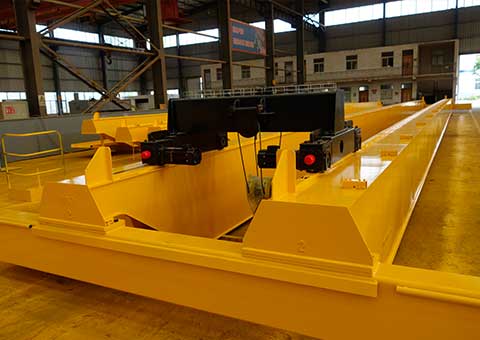


 Geneal use crane
Geneal use crane Crane for food and brevage handling crane-clean room hoist and crane
Crane for food and brevage handling crane-clean room hoist and crane Geneal use overhead crane
Geneal use overhead crane General use gantry crane
General use gantry crane Waste handling crane
Waste handling crane Grab bucket overhead cranes
Grab bucket overhead cranes Workstation crane
Workstation crane Workstation crane
Workstation crane Monorail cranes
Monorail cranes